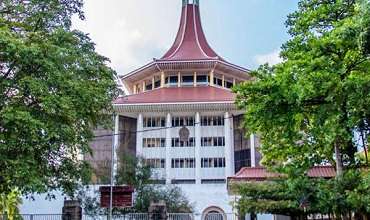Let the Sun Shine: Do not let a photon go to waste without benefit to mankind
The Coronavirus or COVID19 pandemic has affected the entire world shutting down many countries. Now economists are discussing a ‘new economic order’ and ways of going forward. We can take inspiration from a great leader of the past – King Parakramabahu I, who built reservoirs in the 12th century – saving rain water in the North Central Province – to inspire the current generation. Let’s examine how economic development took place during the last thousands of years, giving our citizens confidence and conviction in their heritage, and the future to come.
Accumulated Knowledge
Humans in the Palaeolithic era (15,000 to 750,000 years ago) or Homo sapiens realised that heavy objects could be transported if a round object such as a fallen tree was placed underneath and the heavy object rolled over it. The discovery of fire by prehistoric man, which enabled cooking of raw meat and improvement of lifestyle, led to freeing up time for the development of other elements of culture in society. New discoveries have always had a significant impact on the evolution of mankind. Scientific and technological developments have continued to improve quality of life. The development of the wheel and axel was the beginning of the understanding of the natural world (science) and manipulation of it (technology) for the betterment of mankind. This was the beginning of knowledge based economic development. A case in point is the wonderful creation of Pyramids in Egypt and construction of reservoirs and stupas in ancient Sri Lanka.
R. Buckminster Fuller, futurist and inventor, said that it probably took about 1500 years or thereabouts, until the sixteenth century for that amount of knowledge to double. The next doubling of knowledge from two to four 'knowledge units' took only 250 years, till about 1750 CE. By 1900, one hundred and fifty years later, knowledge had doubled again to 8 units. The speed at which information doubled was getting faster. The speed at which knowledge doubles is now between one and two years as stated in Buckminster Fuller’s 1982 book ‘’Critical Path.’’ Since then knowledge growth rate accelerated dramatically and in new millennium it has to be measured in months. With quantum computers and their immense processing power, it may come down to weeks and days in the next two decades. Can a similarly dynamic future be visualised for energy and electricity?
Industrial Revolution
Accumulated knowledge from the study of nature and fundamental phenomena has contributed vastly to the first industrial revolution that took place between 1780 and 1840 in the United Kingdom. This was the era in which mechanical engineering was developed as a discipline resulting in the conversion of hand production methods to machines, introduction of new chemical manufacturing and iron production processes, the increasing use of steam power and water power(invention of steam engine), the development of machine tools and the rise of the mechanized factory system (mass production of textiles).Terms such as ‘horse power’ are still part of our vocabulary today; a historic reminder of a time when domesticated animals were used to generate mechanical energy. The term continues to be used in measuring engine output. The firstindustrial revolution also led to an unprecedented rise in the rate of population growth.
During the second industrial revolution (1840 – 1900), steel production and railways were developed not only in United Kingdom but all over in Europe, North America and Japan. This allowed for knowledge and information to be moved faster across the world. Then came the third industrial revolution between 1900 and 1950 which led to new innovations in steel production, petroleum and electricity. This resulted in the improvement of lifestyle and standard of living of the people in North America, Britain, Europe, Soviet Union (Russia), Japan etc. It was a period of growth for pre-existing industries and expansion of new ones; such as the steel, oil and electricity fields. The rise of new technologies led to two developments that would change the world: public transport (including air travel) and modern communications (telephony, radio and early television). The use of electricity changed the lifestyle of society through lighting, heating, modern communications and use of electric appliances etc.
After the Second World War, science and inventions which had been revolutionising the life of people in the West, North America, Japan and Soviet Union for nearly a hundred years spread to other countries. This was the era of world economic growth. The United Nations was established and human beings started to think as a collective body, introducing new developments in writing, printing, symbolic calculus, computers, technology and data mining; with advanced economies helping developing nations in their attempt to progress. For example, many countries helped Sri Lanka to complete the Mahaweli Development programme in a short time and construct highways. Thus began the introduction of foreign aid to Sri Lankan development projects, which involved significant international involvements with more developed countries, including soft international relations.
The most important factor in the improvement of life style and standard of living was the use of energy mainly for transport, manufacturing and electricity for domestic use . It is said that increase in per capita income of a nation is directly proportionate to the increase in the use of per capita energy. However, indiscriminate use of energy, with no empathy for the environment, causes problems. For example, the use of coal power stations for generating electricity caused pollution and heavy industrial manufacturing has caused damage to the environment and waterways.
Side effects of Development
In the name of development, communities have paid very little attention to environmental factors. For example, many countries have cleared vast amounts of forest cover and felled trees. Trees that breathe in carbon dioxide (CO2)and breathe out Oxygen (O2), due to photosynthesis,help maintain ecological balance. It is said that areas such as the Amazon forest act as the ‘lungs of the Earth’ maintaining a natural balance. The clearing of treesleads to the reduction of O2 levels in the atmosphere.Trees are also necessary for rain, as they also create the cold and humid atmospheric conditions required. Furthermore,trees absorb the water and help to reduce floods and soil erosion. The burning of fossil fuels for industrial use and in transport, also increases the CO2 in the environment and releases carbon into the atmosphere, upsetting the balance of the carbon cycle.
Greenhouse Effect
The natural process that warms the Earth’s surface is called the ‘’greenhouse effect.’’ When the sun’s energy reaches the Earth’s atmosphere, some of it is reflected back to space and the rest is absorbed and re-radiated. This process maintains the Earth’s temperature to sustain life.
With the dawn of the Industrial Revolution in the 1800s, the burning of fossil fuels such as coal, oil and gasoline have greatly increased the concentration of greenhouse gases - CO2, Methane, Nitrous Oxide, Ozonewith Chlorine and Florine in the atmosphere. As a result re-radiated solar rays cannot escape into the space and get trapped within the earth’s atmosphere. This is the enhanced greenhouse effect, which is contributing in the form of radiation capture by greenhouse gas molecules, to warming of the Earth, causing Earth’s average temperature to rise. This rise in the temperature is called ‘’global warming’’ and this impacts climate change globally.
Climate Change
The climate has continuously changed throughout Earth’s history but it has been a slow, natural process. The tragedy is that the human influenced climate change in the current Anthropocene age, that is happening now, is occurring at much faster rate, affecting national economies and the lives of people in every country on every continent. In other words greenhouse gases lead to health effects such as respiratory disease from smog and air pollution. Extreme weather, food supply disruption due to prolong droughts and increased wildfires are further effects of climate change. Whilst the latter has been experienced more frequently, several countries have experienced a reduction of air pollution due to shutdowns during COVID19. It is estimated that the world’s average temperature would increase by three degrees centigrade in the 21st century, which the UN is attempting to address through climate action to help developing countries towards low-carbon economies. (UN Sustainable Development Goal 13). If suitable action is not taken urgently, this temperature rise is predicted, as stated in the COP 21 goals of the Paris Climate Accord.
Solutions
The way out is to reduce the release of greenhouse gasses and improve the photosynthesis effect to increase O2 creation. The latter can be achieved through reforestation programmes and planting trees. The former is not easily achieved. As explained, access to reliable electricity is vital for human wellbeing and societal development. In 2017, fossil fuels generated 64.5% of worldwide electricity, compared with 61.9% in 1990. This was the trend over the past century, since all governments have been extending the benefits of electricity to their people as a policy. This means releasing of more CO2 gas to the atmosphere, in the name of development. Only way to stall this situation is to use renewable energy sources such as biomass, Hydrogen, ocean, geothermal, hydroelectricity, wind and solar. About 16% of worldwide electricity generation was from hydroelectricity in 2017. The balance 19.5% came from other sources including nuclear power.
On 25th July 2019, Professor Ravi P. Silva, Director, Advanced Technology Institute, University of Surrey; Editor In Chief, Wiley Energy & Environmental Materials, delivered a talk on “Clean, Green and Free: Solar Electricity for 2035”to the National Trust in Colombo. He explained that there are 173,000 terawatts (TW-day) of energy received by the earth from sun on daily basis. The entire human race together, including US use (the largest energy user) only 15 terawatts of energy on a daily basis. This means there is ten thousand times of oversupply of energy coming to the earth (solar power) which can be utilised to provide free electricity to all people in the world.
Electricity generation from sunlight was first discovered in 1839 by Edmond Becquerel, a French physicist who studied the solar spectrum, magnetism, electricity and optics. His research led to the discovery of voltage and electric current in a material upon exposure to light. This was called the photovoltaic (PV) effect and it was the operating principle of the “Solar cell.”
Soon after the discovery of the transistor in 1941 that revolutionised the electronics industry, research on silicon also led to the invention of the currently used solar cell. Further research was successful in the conversion of light into electricity through the study of physics, photochemistry and electrochemistry. This discovery was the starting point that will change the future of the world by 2035, which aims to make free electricity available to the masses.
Silicon solar cells are used to assemble into larger modules that can be installed into rooftops of residential or commercial buildings or used on ground mounted racks to create solar parks. The cells made from silicon are generally less costly and efficient. The efficiency is measured in terms of the rate at which the cells convert sunlight into electricity. At the COP21 (the Paris Agreement) held in December 2019, leaders of more than 170 countries agreed to reduce greenhouse gas emissions and limit the global temperature increase to below 2 degrees Celsius above pre-industrial levels by 2100. This is aimed at combating climate change and to accelerate and intensify the actions and investments needed for a sustainable low carbon future.
Professor Ravi P. Silva suggested that the stakeholders should look at the 173,000 terawatts (TW days) of energy receive by the earth from Sun on daily basis. He points out that with the development of solar power electricity the fossil fuel power could be substituted by renewable energy leading to a greener world. He argues that Sri Lanka with its natural geography and developed hydroelectric infrastructure could provide not just the base load, but also pumped energy storage capacity in daytime, to be used at night. His other arguments are that water can be desalinised to ease the water stress in the country, particularly for the Northern regions, and part of the water released from reservoirs for cultivation could be pumped back and reused to store energy for the time when the sun does not shine since sufficient electricity is available cheaply to operate high capacity pump stations.
Estimated installed electricity capacity in Sri Lanka in the year 2018 was 4,269 MW (4.3GW). To supply this entire amount, we need only 25 square kilometres of space which is only 0.04% of our land area of 65,610 km2. This does not need to be arable land or urban areas, and can even be floating installations. Sri Lanka has an abundance of sunlight throughout the year. Professor Silva said that this is part of our environmental heritage; not tangible like Sigiriya or the ancient ruins in Polonnaruwa, but intangible and real to our people. One of our greatest kings, Parākramabāhu I, considered rainfall received as a heritage and said ‘not a single drop of water received from rain should be allowed to escape into the sea without utilising it for the benefit of our people.’
Likewise, we should not allow a single photon of sunlight that we receive, go waste without utilising it for the benefit of mankind. The new economic order should be aimed at a green economy based on sunlight energy. Sri lanka has the geological infrastructure and abundance of sunlight to make this a reality. The challenge for leadership is to allow for the change and revitalisation of our heritage in modern times. Professor Silva thanked the National Trust of Sri Lanka for the privilege in inviting him for this talk.
This article is dedicated to DeshamanyaVidyaJyothiDr. Roland Silva,one of Sri Lanka’s most prominent archaeologists who was an inspiration to many in Sri Lanka on National Heritage, and passed away on the 1st Jan. 2020. His son Professor Ravi P. Silva, gladly agreed to co-author this article to create an awareness among the Sri Lankans on the power of Solar Energy to achieve a ‘’green economy.’’
Rohan Abeygunawardena ACMA, CGMA
-
Still No Comments Posted.

















Leave Comments